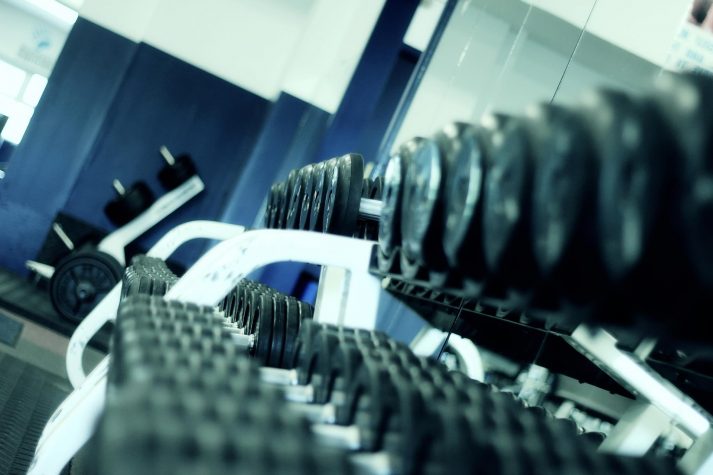This
post was originally published on
this siteOriginally posted at: http://www.nerdfitness.com/
I hear two common excuses every day from people who don’t work out.
- “I don’t have time.”
- “I get bored.”
Well there Rebel, you’re in luck (unless you love excuses).
Today we are going to talk about circuit training! It’s fast, varied, and effective. If you find yourself with no time to get sweaty or getting bored on a treadmill, a circuit training workout could be just what the doctor ordered.

Or not.
But if you have a doctor prescribe you circuit training, that doctor is awesome.
Consider this the ultimate guide for circuit training! I’ll explain the benefits below, but if you’re just looking for routines to follow, click each below to take you to that workout:
Some of the workouts will have multiple circuit choices for you to pick, depending on your fitness level. If I did the math right, there’s 15 total.
Let’s go!
What is circuit training?

The “circuit” in circuit training comes from the fact that you do a sequence of exercises back to back to back, and then you repeat the sequence. And then again. You cycle through the planned sequence of exercises, or circuit, multiple times.
That’s circuit training.
Generally you hit each major muscle group during one full circuit. You may do lower body for one exercise. Then upper body the next.
You’ll find all sorts of difference circuit training sequences. Here’s some things most will have in common:
- Several different exercises. A normal circuit will have five to ten different movements per circuit. You’ll often hear these referred to as “stations.” Overhead press station, squat station, etc.
- Little to no rest in between. The goal of circuit training is to keep your heart rate up. Ideally, if you’re physically able, you go from one exercise to another without stopping. Maybe you rest after the whole circuit. Maybe.
- Rinse and repeat. Generally you’ll run through your circuit a few times. Three rounds is common.
Make sense? The point here is to work different parts of your body with different exercises, and then while those parts are recovering, you’re working on your other movements! This helps build cardiovascular health, while also improving muscular endurance and strength. Plus you’ll burn calories!
As we lay out in our article, Cardio vs Interval Training vs. Weight Training, research supports that doing strength training circuits is great for weight loss and overall health. More importantly, for somebody with limited time, doing a strength training circuit is more effective at building strength and burning fat than an equivalent amount of cardio.
In other words, if you are trying to lose weight, you should be doing circuit training.
Now, I understand this stuff can be confusing, and knowing which workout to follow for your body type and goals is really challenging. Which circuit? How should you be eating? How many days should you rest between workouts? What is the meaning of life!?
If that sounds like you, you’re not alone.
Answering questions like these is what lead us to create our 1-on-1 coaching program.
(Admittedly, we’re still working on the “meaning of life” one).
So here’s how it works: we get to learn each person’s goals, lifestyle, challenges, and situation: kids? night shift? travel frequently? All the above? We got you covered.
Then we pair that person with a coach from Team Nerd Fitness that fits their personality, gets to know them better than they know themselves, and builds a custom workout program and nutrition guidance to help them reach their goals!
Want to see if we are a good fit for each other? Click on the button below to schedule a free call, and we can decide if this is something that can help you reach your goals!

Why Should I do circuit training?

Generally, you’ll hear exercise divided into strength training or aerobic exercise (cardio).
What’s the difference, you wonder?
- Strength training. Strength training is also referred to as anaerobic exercise, which would be a short burst of energy for movement. Think of a push up or pull up. These exercises help build and tone muscle.
- Aerobic Exercise. “Aerobic” means “needs oxygen.” Your heart rate increases to get oxygen where your body needs it, thus the word “cardio.” Running, biking, or jumping jacks would be examples of aerobic exercise.
The thing about a circuit is, you actually do both categories. Presses and lunges fall into strength training. Jumping jacks are cardio. And since you aren’t stopping much in between stations, you’ll need more oxygen, and voila. Even more cardio.
With circuit training, you build muscle and burn fat WHILE building stamina.
As Michael Scott would say, “that’s a win, win win.”

There’s some debate on what kind of exercise is better for weight loss: aerobic or anaerobic.
My thoughts? If you’re limited on time and only can pick one, I would pick strength training: when you strength train, you break your muscles down, and your body needs to work extra hard over the next 24-48 hours to rebuild those muscles (with increased calories burned).
Don’t overthink this though, we can cover both with a circuit.
Before and after your circuit training: Warm up and stretch

No matter which circuit you pick, I want you to start with one important thing:
Warm up!
I cover why to warm up in an article found right here. It doesn’t have to be much though, give it about five minutes to get your muscles active and your heart rate up. This will help you do exercises properly and help prevent injury. You can run in place, do air punches and kicks, or some jumping jacks.
Here is NF Senior Coach Staci (you might know her incredibly story) showing you many beginner options you can use to warm up as well:
Did I just tell you to prepare for circuit training, with a circuit?!
If you’re curious, here’s my personal warm-up:
- 2-3 minutes of jump rope
- 25 jumping jacks
- 20 body weight squats
- 5 lunges
- 10 hip extensions
- 5 hip rotations each leg
- 10 forward leg swings
- 10 side leg swings
- 10-20 push ups
- 10 spiderman steps
Our goal isn’t to tire you out, instead we want to warm up you up. That’s step one.
Completing your chosen circuit training routine would be step two. Below, you’ll find 15 workouts you can follow along with!
Beginner Bodyweight Workout Circuit
This workout circuit, as we lay out in our Beginner Bodyweight Workout article, is as follows:
- 20 bodyweight squats
- 10 push ups
- 20 walking lunges – 10 each leg
- 10 dumbbell rows (using a gallon milk jug or another weight)
- 15 second plank
- 30 jumping jacks
Run through this circuit three times. If you don’t have milk in the house for the rows, find something of roughly the same weight with a good handle.
If you want to download this Beginner Bodyweight Workout as a worksheet, you can do so when you sign up in the box below:
Grab Your Beginner Bodyweight Routine Worksheet. No Gym Required!
- Complete this workout at home, no equipment required
- Avoid the common mistakes everybody makes when doing bodyweight exercises
- Learn how to finally get your first pull-up
Advanced Bodyweight Exercises Circuit
If the beginner circuit above is too easy for you, move on to our Advanced Bodyweight Workout Circuit. Check out the original article where we covered it here. The workout looks like this:
- 10 one legged squats – each side [warning super-difficult, only attempt if you’re in good enough shape]
- 20 body weight squats
- 20 walking lunges (10 each leg)
- 20 jump step-ups (10 each leg)
- 10 pull ups [or inverted bodyweight rows using your kitchen table]
- 10 dips – bar stools
- 10 chin ups [or inverted bodyweight rows with underhand grip]
- 10 push ups
- 30 second plank
I warn you, the above circuit will hurt… in a good way. You should be proud if you can get through this three times.
Playground Workout Circuit
Do you have a nearby playground? Why not workout there! If you have kids, you can do it together. Or let them ignore you.
I’ll give you a Level One workout, and a Level Two. Check out the main playground article for some Level Three exercises.
Level One
- 20 Alternating Step Ups (10 each leg)
- 10 Elevated Push Ups
- 10 Swing Rows
- 8 Assisted Lunges
- 10 Bent Leg Reverse Crunches
Level Two
- 10 Bench Jumps
- 10 Lower Incline Push Ups
- 10 Body Rows
- 8 Lunges
- 10 Straight Leg Reverse Crunches
After you’ve gone through a complete set three times, go down the slide!
Kettlebell Workout Circuit
Have a kettlebell lying around? Use it for a circuit!
Here’s our kettlebell workout full write-up, but you can also just watch the video and see the workout here:
- 8 Halos (each side)
- 10 Goblet Squats
- 8 Overhead Presses (each side)
- 15 Kettlebell Swings
- 8 Bent Over Rows (each side)
- 6 Front Rack Reverse Lunge (per side)
Once you’ve done the above three times, go ahead and put your kettlebell away for your final step: stretches.
If you want a kettlebell worksheet, grab one by signing up in the box below:
Grab Your Beginner Kettlebell Routine Worksheet!
- Complete this workout at home or gym with 1 kettlebell.
- Avoid the common mistakes everybody makes when doing kettlebell exercises.
- Build strength, burn fat, level up your life!
Beginner Gym Circuit Training

If you have access to a gym, you have a lot of circuit options. If you
If it’s your first time stepping foot in a fitness facility, check out our Beginner’s Guide to the Gym. The gym can be a scary place, but we’ll give you a strategy to get comfy.
We’ll also walk you through each movement above, for both Days A and B below. I would recommend reading that article, going through the leveled progressions, and working your way up to the circuits below:
Day A
Day B
Alternate your circuits on different days. Rest in between. “Day A” could be Monday. Rest Tuesday. Wednesday could be “Day B.”
The Hotel Workout Circuit: For Travelers that Train

Sometimes, you just plain find yourself stuck in a hotel room. Maybe you can find the hotel gym, but I bet it’s terrible! It probably has 2 machines, a broken treadmill, and no free weights.
Ugh.
Instead, how about a workout circuit you can do in the room itself! Utilize the furniture to its full potential.
Level 1
Level 2
Set the alarm clock to 15 minutes from now and see how many circuits you can do!
Check out our full post on hotel circuits if you want Level 3!
Nerdy Circuit Training Exercises

If those workouts above don’t tickle your fancy, we have these other nerdy circuits you can do too!
Day 1
- 5 Rolling Squat Tuck-up Jumps
- 5 Side to Side Push-ups
- 5 Modified Headstand Push-ups
- 5 Jump Pull-Up with tuck / Pull-Up with Tuck-Up
- 8 Second Handstands against wall
Day 2
- 5 ‘180 Degree’ Jump Turns
- 8 Second Tuck Front Lever Hold
- 8 Second Tuck Back Lever Hold
- 8 Second Low Frog Hold

Superset 1: The Fellowship of the Ring
- 3 “YOU SHALL NOT PASS!” Slams (3 medicine ball slams)
- 7 Legolas Bow Pulls (7 renegade rows).
- 9 “One does not simply walking lunge into Mordor” (9 lunges, each leg).
- 1 Minute: Hip “Bridge of Khazad Dum” (hip raises and hold at the top position for 1 minute)
Superset 2: The Two Towers
- 3 Riders of ROWhan (3 bodyweight rows)
- 7 Gimli “Shall I get you a box?” jumps. (7 box jumps – REALLY explode)
- 9 Helm’s Deep-Squats. (9 bodyweight squats – get your ass to the ground. Way down.)
- 1 Minute Tower of Orthanc Holds (Kick up against a wall and hold a handstand for as long as you can until 1 minute is complete, in as few as sets as possible. Can’t hold a full handstand? Check out the variations in our Guide to Handstands.)
Superset 3: The Return of the King
If you can get through a superset three times, consider yourself an honorary Ranger. Nothing found in Mordor can faze you.

The below circuit is no joke. Then again, neither were the Spartans.
- 25 Pullups – 25 reps
- 50 Deadlifts with 135lbs
- 50 Pushups
- 50 ‘24-inch’ Box jumps
- 50 Floor wipers
- 50 Single-arm Clean-and-Press with 36lbs Kettlebell
- 25 Pullups
The above sequence is designed to be completed once. If you can go through it twice, you’re ready to defend Greece.
- 10 Barbell Deadlift / Dumbbell RDL / Banded Good Morning / Regular Good Morning
- 10 Medicine Ball Slam / Quick Downwards Bodyweight Squat
- 10 Push-up to Renegade Row (push-up, row left, push-up, row right, repeat) [5 Rows per side]
- 5 Transverse Lunge and Chop (alternate between the two)
How many times do you do this circuit? AMRAP, or, As Many Rounds As Possible. I suggest setting a 12 minute timer and getting to work. Be careful though, because only Wolverine can heal automatically.

You’ll need actual rest.
Boom! There are your nerdy circuits. Feel free to rock the soundtrack of the referenced movies during your workout. If you own a cape, now’s the time.
How to Stretch After Circuit Training
Once you finish your workout, the final step (three) would be stretching and cool down. No matter what circuit you go through, stretch after. It can help a lot with muscle recovery.
Scope this video for an awesome stretching sequence to follow:
You could also do some yoga poses. For stretching, find what feels good and take your time. Let your heart rate come down while you stretch.
You could even do some foam rolling too if you’re a glutton for punishment!
Getting Started With Circuit Training

There are all sorts of different ways to do circuit training. We just showed you fifteen.
YOUR MISSION: Complete one of the above circuit training workouts! If you don’t know which one to pick, start with the Beginner Bodyweight Circuit. It’ll get you used to the idea of hustling from one exercise to the next. And you can do it in your living room!
If you got this far in the article, I really want you to try one of these workouts. Right NOW. I always mention the most important step in a fitness journey is starting it. Today, start circuit training.
Once completed, I’d love for you to share your story with the community in the comments:
- How’d it go?
- Did you get through three full circuits?
- Which routine did you pick?
As a reminder, if you need someone to hold you accountable to follow through on circuit training, we have coaches who can do just that. Our 1-on-1 Coaching program can create an exercise routine just for you, no matter what your situation is.
Find a circuit you’re comfortable with, and do it. Then do it next week. And the following. If you add circuit training to your fitness routine, you’ll be on a solid path for leveling up your life.
-Steve
PS: I couldn’t quite figure out how to use this gif, but it was too good not to include.

If someone creates the “Short Circuit Workout Circuit” you’ll be my best friend forever.
###
All Photo credits can be found right here[1].


 Today’s guest post is generously offered up by Craig Emmerich, husband to—and co-author with—the queen of keto herself, Maria Emmerich. Enjoy!
Today’s guest post is generously offered up by Craig Emmerich, husband to—and co-author with—the queen of keto herself, Maria Emmerich. Enjoy!






















 For now classes are 6pm and 640pm at 2840 Wildwood st in the Boise Cloggers studio.
Book your class NOW!
click this ==>
For now classes are 6pm and 640pm at 2840 Wildwood st in the Boise Cloggers studio.
Book your class NOW!
click this ==>








